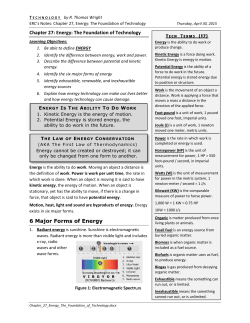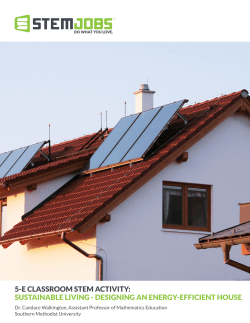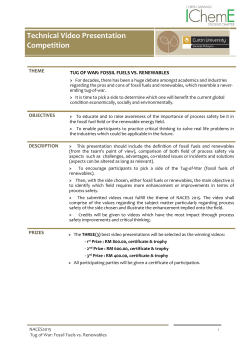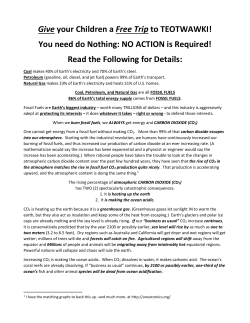
Physics Knowledge Bank
BTEC Unit 1 Physics Revision Learning Aim E: Energy Stores, Energy Transfers and Energy Transformations Forms of Energy and Their Uses Description and Use Kinetic (Mechanical) The energy in moving objects. Also called movement energy. Kinetic energy is stored in a moving object. A bullet cutting a playing card Heat Also called thermal energy. Given out by hot objects; used to turn water into steam to drive a turbine to generate electricity. Thermal energy is stored in a hot object Burning match Light Used in light bulbs, street lamps, torches, candles and the Sun Sunlight Sound Energy released by vibrating objects Used for musical instruments and for speech as the air vibrates. Guitar Electrical Energy in moving or static (stationary) electric charges. Used to supply energy to our homes. Used in many household devices eg TV, washing machine, hair dryer etc Lightning Elastic potential Stored energy in stretched or squashed objects Used in catapults and anything with a spring inside it. Elastic energy is stored when a spring or rubber band is stretched. Catapult Nuclear Stored in the nuclei of atoms Used in electrical energy generation. Nuclear fuel assembly Gravitational Potential Energy (GPE) A rock on a mountain has stored energy because of its position above the ground and the pull of gravity. This energy is transferred to kinetic energy when falling. Energy transfers 1. Conduction Heat energy can move through a substance by conduction. Metals are good conductors of heat but nonmetals and gases are usually poor conductors of heat. Poor conductors of heat are called insulators. Heat energy is conducted from the hot end of an object to the cold end by the hot particles vibrating (kinetic energy) and colliding with the colder particles. 2. Convection Liquids and gases can move from place to place. Convection occurs when particles with a lot of heat energy in a liquid or gas move and take the place of particles with less heat energy. 3. Infrared radiation All objects emit (give out) and absorb (take in) thermal radiation, which is also called infrared radiation. The hotter an object is, the more infrared radiation it emits. Infrared radiation is a type of electromagnetic radiation (wave). This means that, unlike conduction and convection, radiation can even pass through the vacuum of space as it does not need particles to pass the energy on. Light from the sun reaching earth 4. Sound Waves Sound is caused by movement of the particles in the air. Something vibrates, like a speaker cone and by moving in time to the music the speaker forces the air to move as well. This is called a vibration. The vibrations moves through the air until they reach your ear and cause your ear drum to move. In this way energy in the sound is moved from place to place. 5. Electrical Energy Transfer When a device (light bulb) uses electricity to work it uses the electrical energy to do a job. The energy is transferred into a different form. In this example electrical energy transforms into light energy (useful) and heat energy (waste). Energy is measured in Joules (J) Energy is never lost or destroyed or created but energy can be turned into different forms, this is the principle of conservation of energy. Sources and Storage of Energy Fossil fuels Coal, oil and natural gas are called fossil fuels. They formed millions of years ago from the remains of living things. The energy stored in the fossil fuels originally came from sunlight. Plants used light energy from the Sun for photosynthesis to make their chemicals. This stored chemical energy was transferred to stored chemical energy in animals that ate the plants. When the living things died, they were gradually buried by layers of rock. The buried remains were put under pressure heated them up. They gradually changed into the fossil fuels. When the remains of the plants and animals became fossil fuels, their chemical energy was stored in the fuels. The energy is transferred to the surroundings as thermal energy and light energy when the fuels burn. Once we have used them all up, they will take millions of years to replace, if they can be replaced at all. For this reason we call fossil fuels non-renewable energy resources. Renewable Energy Solar Power Solar cells are devices that convert light energy directly into electrical energy. Solar cells are used to power road signs, and even satellites in orbit around Earth. Solar panels can be used in very remote locations and produce no pollution but only work when the sun is shining. Wind power Wind has huge amounts of kinetic energy, and this can be transferred into electrical energy using wind turbines. Wind turbines cannot work if there is no wind, or if the wind speed is so high it would damage them. Learning Aim F: The Electromagnetic Spectrum Electromagnetic radiation Uses Dangers radiowaves TV and radio signals (broadcasting) and satellite transmissions microwaves cooking satellite transmissions Internal heating of cells eg: brain cells when using a mobile phone infrared cooking optical fibres thermal imaging television remote controls security systems (infrared beams) Skin Burns visible light Optical fibres photography illumination vision ultraviolet security marking fluorescent lamps detecting forged bank notes fluorescent lamps sterilising water Sunburn, damage to skin cells which can lead to skin cancer X-rays airport security scanners medical X-rays observing the internal structure of objects Mutation of cells which can cause cancer gamma rays sterilising food and medical equipment detection of cancer and killing cancer cells Mutation of cells which can cause cancer
© Copyright 2025









